 fist, the T4 phage uses its tail fibers to bind to specific receptor sites on the outer surface of cell, and the sheath of the tail contracts, ingecting the phage DNA into the cell and leaving an empty capsid ouside. the cell's DNA is hydolyzed. The phage DNA directs production of phage proteins and copies of the phage genome by host enzymes, using cimponents withing the cell. three separates sets of proteins self-assemble to form phage heads, tails, and til fivers. the phage genome is pakcaged inside the capsid as the head forms, it released with a lot of damages on the cell.
fist, the T4 phage uses its tail fibers to bind to specific receptor sites on the outer surface of cell, and the sheath of the tail contracts, ingecting the phage DNA into the cell and leaving an empty capsid ouside. the cell's DNA is hydolyzed. The phage DNA directs production of phage proteins and copies of the phage genome by host enzymes, using cimponents withing the cell. three separates sets of proteins self-assemble to form phage heads, tails, and til fivers. the phage genome is pakcaged inside the capsid as the head forms, it released with a lot of damages on the cell.http://www.youtube.com/watch?v=Rpj0emEGShQ
In 1898, Friedrich Loeffler and Paul Frosch found evidence that the cause of foot-and-mouth disease in livestock was an infectious particle smaller than any bacteria. This was the first clue to the nature of viruses, genetic entities that lie somewhere in the grey area between living and non-living states. A virus is defined as any of a various number of submicroscopic parasites that can infect any animal, plant or bacteria and often lead to very serious or even deadly diseases. A virus consists of a core of RNA or DNA, generally surrounded by a protein, lipid or glycoprotein coat, or some combination of the three. No virus can replicate without the help of a host cell, and though they can be spread, viruses lack the ability of self-reproduction and are not always considered to be living organisms in the regular sense. Viruses may have double-stranded DNA, double-stranded RNA, single-stranded DNA or single-stranded RNA. The type of genetic material found in a particular virus depends on the nature and function of the specific virus. The genetic material is not typically exposed but covered by a protein coat.
No comments:
Post a Comment